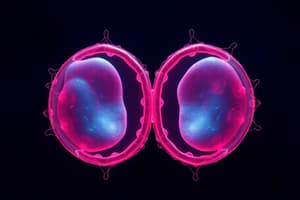Podcast
Questions and Answers
What is the chromosome configuration of germ cells before meiosis starts?
What is the chromosome configuration of germ cells before meiosis starts?
- Haploid with one set of chromosomes
- Triploid with three sets of chromosomes
- Diploid with two sets of chromosomes (correct)
- Tetraploid with four sets of chromosomes
Which phase of meiosis occurs after metaphase I?
Which phase of meiosis occurs after metaphase I?
- Prophase I
- Telophase II
- Anaphase II
- Anaphase I (correct)
During which phase do chromosomes undergo replication in meiosis?
During which phase do chromosomes undergo replication in meiosis?
- G2 phase of interphase (correct)
- Prophase I
- Metaphase II
- Anaphase I
Which statement correctly describes the outcome of meiosis?
Which statement correctly describes the outcome of meiosis?
In which of the following phases do sister chromatids separate?
In which of the following phases do sister chromatids separate?
What event occurs during stage 'a' of Meiosis II?
What event occurs during stage 'a' of Meiosis II?
What is the main function of the spindle apparatus during Meiosis II?
What is the main function of the spindle apparatus during Meiosis II?
Which stage of Meiosis II leads directly to the formation of gametes?
Which stage of Meiosis II leads directly to the formation of gametes?
During which stage do the sister chromatids move toward opposite ends of the cell?
During which stage do the sister chromatids move toward opposite ends of the cell?
What happens in stage 'c' of Meiosis II?
What happens in stage 'c' of Meiosis II?
What is the primary purpose of meiosis in organisms?
What is the primary purpose of meiosis in organisms?
In humans, where does meiosis primarily take place?
In humans, where does meiosis primarily take place?
How many haploid cells are produced from a single diploid cell after meiosis?
How many haploid cells are produced from a single diploid cell after meiosis?
What characterizes the chromosome number in haploid cells produced by meiosis?
What characterizes the chromosome number in haploid cells produced by meiosis?
Which statement best describes genetic diversity as a result of meiosis?
Which statement best describes genetic diversity as a result of meiosis?
What type of cell division is meiosis classified as?
What type of cell division is meiosis classified as?
What is the significance of the fusion of male and female gametes during fertilization?
What is the significance of the fusion of male and female gametes during fertilization?
What type of cell division occurs first in the zygote following fertilization?
What type of cell division occurs first in the zygote following fertilization?
Which statement best describes homologous chromosomes?
Which statement best describes homologous chromosomes?
What is formed immediately after the fusion of gametes?
What is formed immediately after the fusion of gametes?
Which of the following describes the chromosomal composition of the offspring compared to the gametes?
Which of the following describes the chromosomal composition of the offspring compared to the gametes?
How many different orientations can two pairs of chromosomes have during Metaphase I of meiosis?
How many different orientations can two pairs of chromosomes have during Metaphase I of meiosis?
What is the total number of possible chromosome combinations in humans due to orientations during Metaphase I?
What is the total number of possible chromosome combinations in humans due to orientations during Metaphase I?
If two pairs of chromosomes can orient in four ways, how does this scale with an increase to 23 pairs?
If two pairs of chromosomes can orient in four ways, how does this scale with an increase to 23 pairs?
Which of the following best describes the X shape representation of chromosomes during Metaphase I?
Which of the following best describes the X shape representation of chromosomes during Metaphase I?
What factor primarily contributes to genetic variation during Metaphase I of meiosis?
What factor primarily contributes to genetic variation during Metaphase I of meiosis?
Why is the orientation of chromosomes during Metaphase I important for genetic diversity?
Why is the orientation of chromosomes during Metaphase I important for genetic diversity?
Which statement regarding chromosome orientation during meiosis is accurate?
Which statement regarding chromosome orientation during meiosis is accurate?
How do the orientations during Metaphase I correlate to a cell's ploidy level?
How do the orientations during Metaphase I correlate to a cell's ploidy level?
What occurs during Anaphase I of meiosis?
What occurs during Anaphase I of meiosis?
What is the outcome of Telophase I in meiosis?
What is the outcome of Telophase I in meiosis?
During which stage of meiosis does the cell membrane begin to constrict?
During which stage of meiosis does the cell membrane begin to constrict?
Which diagram best represents the completion of cytokinesis after Telophase I?
Which diagram best represents the completion of cytokinesis after Telophase I?
What does each new cell contain after Anaphase I?
What does each new cell contain after Anaphase I?
Which statement is true regarding the chromosomes during Meiosis I?
Which statement is true regarding the chromosomes during Meiosis I?
Which of the following is NOT a key feature of Telophase I?
Which of the following is NOT a key feature of Telophase I?
What role does cytokinesis play following Telophase I?
What role does cytokinesis play following Telophase I?
In what stage are chromosomes observed moving to opposite poles?
In what stage are chromosomes observed moving to opposite poles?
What is the primary significance of the arrangement of chromosomes during metaphase I?
What is the primary significance of the arrangement of chromosomes during metaphase I?
In metaphase I, how are the homologous pairs of chromosomes positioned in relation to the cell's equator?
In metaphase I, how are the homologous pairs of chromosomes positioned in relation to the cell's equator?
What role do spindle fibers play during metaphase I?
What role do spindle fibers play during metaphase I?
Why is the random assortment of chromosomes in metaphase I important for sexual reproduction?
Why is the random assortment of chromosomes in metaphase I important for sexual reproduction?
What visual characteristic is seen in the diagram of a cell in metaphase I?
What visual characteristic is seen in the diagram of a cell in metaphase I?
How does the arrangement of chromosomes during metaphase I contribute to genetic diversity?
How does the arrangement of chromosomes during metaphase I contribute to genetic diversity?
What happens to the chromosomes after metaphase I is complete?
What happens to the chromosomes after metaphase I is complete?
Which of the following best describes the nature of chromosome positioning in metaphase I?
Which of the following best describes the nature of chromosome positioning in metaphase I?
Which aspect of meiosis is exemplified by the events occurring during metaphase I?
Which aspect of meiosis is exemplified by the events occurring during metaphase I?
What is the likely outcome of a malfunction in spindle fiber attachment during metaphase I?
What is the likely outcome of a malfunction in spindle fiber attachment during metaphase I?
Flashcards
Meiosis II Stages
Meiosis II Stages
Meiosis II is a type of cell division where a single cell divides into four daughter cells, called gametes.
Spindle forms in Meiosis II
Spindle forms in Meiosis II
The spindle fibers form and attach to the chromosomes, allowing them to be moved around the cell.
Sister chromatids separate
Sister chromatids separate
The spindle fibers contract pulling the sister chromatids apart.
Daughter cells form
Daughter cells form
Signup and view all the flashcards
Gamete Production
Gamete Production
Signup and view all the flashcards
Germ Cell
Germ Cell
Signup and view all the flashcards
Meiosis I Phases
Meiosis I Phases
Signup and view all the flashcards
Interphase
Interphase
Signup and view all the flashcards
Diploid cell
Diploid cell
Signup and view all the flashcards
What is Meiosis?
What is Meiosis?
Signup and view all the flashcards
Gametes
Gametes
Signup and view all the flashcards
Reduction division
Reduction division
Signup and view all the flashcards
Diploid to haploid
Diploid to haploid
Signup and view all the flashcards
How many cells produced?
How many cells produced?
Signup and view all the flashcards
Purpose of meiosis
Purpose of meiosis
Signup and view all the flashcards
Metaphase I
Metaphase I
Signup and view all the flashcards
Homologous Chromosomes
Homologous Chromosomes
Signup and view all the flashcards
Chromosome Orientation
Chromosome Orientation
Signup and view all the flashcards
Independent Assortment
Independent Assortment
Signup and view all the flashcards
Possible Combinations
Possible Combinations
Signup and view all the flashcards
Genetic Diversity
Genetic Diversity
Signup and view all the flashcards
Meiosis I vs. Meiosis II
Meiosis I vs. Meiosis II
Signup and view all the flashcards
Fertilization
Fertilization
Signup and view all the flashcards
Zygote
Zygote
Signup and view all the flashcards
Diploid
Diploid
Signup and view all the flashcards
Haploid
Haploid
Signup and view all the flashcards
What happens during Anaphase I?
What happens during Anaphase I?
Signup and view all the flashcards
What is the outcome of Anaphase I?
What is the outcome of Anaphase I?
Signup and view all the flashcards
What happens during Telophase I?
What happens during Telophase I?
Signup and view all the flashcards
What is the outcome of Telophase I?
What is the outcome of Telophase I?
Signup and view all the flashcards
How many cells are formed after Meiosis I?
How many cells are formed after Meiosis I?
Signup and view all the flashcards
What is the ploidy of the cells after Meiosis I?
What is the ploidy of the cells after Meiosis I?
Signup and view all the flashcards
What does 'homologous' mean?
What does 'homologous' mean?
Signup and view all the flashcards
What is the purpose of Meiosis I?
What is the purpose of Meiosis I?
Signup and view all the flashcards
What does 'haploid' mean?
What does 'haploid' mean?
Signup and view all the flashcards
How does Meiosis I differ from Mitosis?
How does Meiosis I differ from Mitosis?
Signup and view all the flashcards
Random Assortment
Random Assortment
Signup and view all the flashcards
What does Random Assortment achieve?
What does Random Assortment achieve?
Signup and view all the flashcards
Homologous Pairs
Homologous Pairs
Signup and view all the flashcards
What is the purpose of Metaphase I?
What is the purpose of Metaphase I?
Signup and view all the flashcards
What happens to the chromosomes in Metaphase I?
What happens to the chromosomes in Metaphase I?
Signup and view all the flashcards
How many chromosomes are on each side in Metaphase I?
How many chromosomes are on each side in Metaphase I?
Signup and view all the flashcards
What happens after Metaphase I?
What happens after Metaphase I?
Signup and view all the flashcards
What is a key outcome of Metaphase I?
What is a key outcome of Metaphase I?
Signup and view all the flashcards
Why is Metaphase I crucial?
Why is Metaphase I crucial?
Signup and view all the flashcards
Study Notes
Meiosis
- Meiosis is a type of cell division that occurs in reproductive organs (testes and ovaries in humans).
- It produces gametes (sperm and egg cells).
- It is a reduction division. It reduces the number of chromosomes from diploid to haploid.
- A diploid cell divides twice to produce 4 haploid cells which are genetically different.
- The purpose of meiosis is sexual reproduction.
- It is fundamental in the passing of genetic information from parent to offspring, while also creating genetic diversity in future generations.
- Meiosis begins in a specific cell called a germ cell (zārodocná bunka), which like most of the cells is diploid.
- Germ cells undergo the G1, S, and G2 phases of interphase.
- Cells undergoing meiosis divide twice:
- Meiosis I:
- prophase I
- metaphase I
- anaphase I
- telophase I
- Meiosis II:
- prophase II
- metaphase II
- anaphase II
- telophase II
- Meiosis I:
Studying That Suits You
Use AI to generate personalized quizzes and flashcards to suit your learning preferences.




